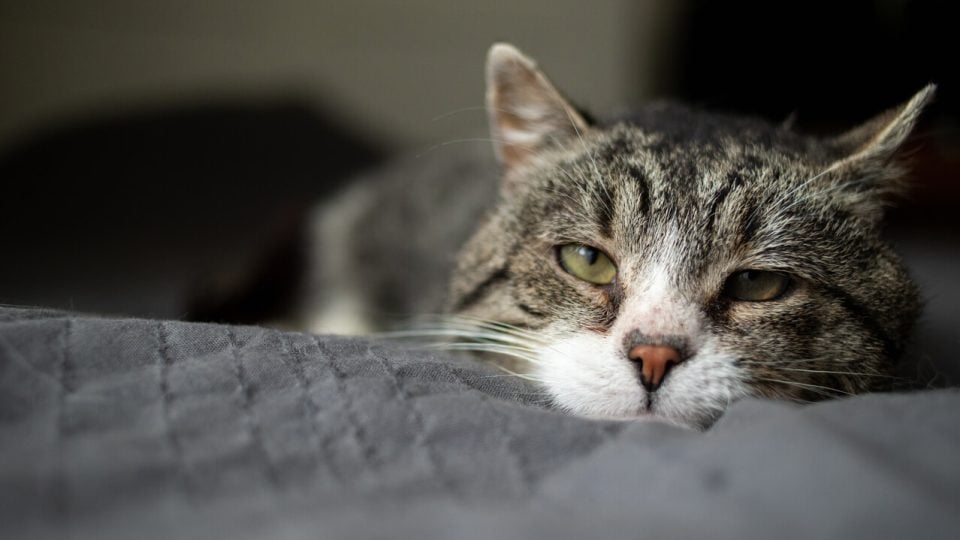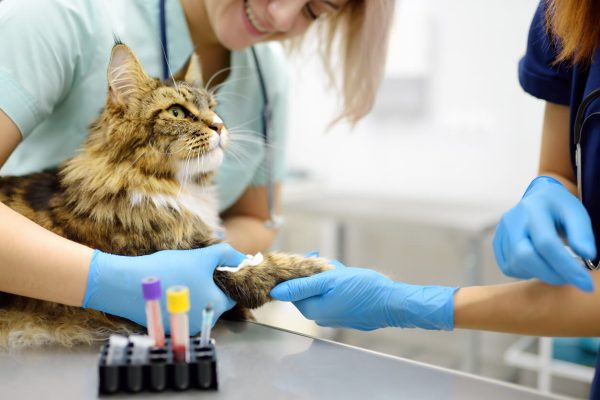- Not a substitute for professional veterinary help.
Have you recently noticed a yellowish tint to your cat’s eyes, skin, and gums? This color change may not be a trick of the light. Your cat could have jaundice. Jaundice in cats stems from liver issues and can point to serious health concerns.
“Jaundice happens when there are elevated levels of bilirubin in the blood,” says Dr. Preston Turano, DVM, veterinary advisor to Felix Cat Insurance. Bilirubin is yellowish-brown waste formed from broken-down red blood cells typically processed through the liver. If the liver can’t process the bilirubin in the body, jaundice will develop.
Dr. Turano adds that jaundice isn’t a diagnosis or disease, but a clinical sign that points to an underlying disease. If you notice signs of jaundice, it’s important to make an appointment with your vet right away.
Catching and treating the underlying condition can address jaundice and improve your cat’s chances of recovery.
Read on to learn what causes jaundice in cats and what to do next.
What Causes Jaundice In Cats?
The most common cause of jaundice is liver dysfunction, according to Dr. Turano and Dr. Christine Deeke, Lead Veterinarian at CityVet Frisco.
Two types of liver dysfunction that can lead to jaundice include:
- Blocked bile duct (biliary obstruction): A blocked bile duct can lead bile to build up in the liver. This can lead to digestion problems, serious nutritional deficiencies, and life-threatening infections. Blocked bile ducts can happen for many reasons, including gallstones, intestinal inflammation in the duodenum, tumors, parasitic infections, and some cancers.
- Feline hepatic lipidosis (FHL): FHL, also known as fatty liver syndrome, is one of the most common liver diseases in cats. FHL often happens as a side effect of chronic health conditions like diabetes and inflammatory bowel disease. Cats who are overweight also have a higher risk of FHL. It’s often fatal without prompt treatment.
Other causes of jaundice in cats
Cats can also develop jaundice due to:
- Ingesting toxins
- Haemoplasma, an infection of red blood cells
- Hemolytic anemia, which happens when a cat’s immune system attacks their red blood cells
- Pancreatitis
- Cancer
- Feline Leukemia Virus (FeLV)
- Feline Immunodeficiency Virus (FIV)
Signs And Symptoms To Pay Attention To
Here are nine common symptoms linked with jaundice in cats:
- Yellowing of the skin, inner ears, gums, and the whites of the eyes
- Decreased appetite or food avoidance
- Vomiting
- Diarrhea
- Lethargy
- Sudden, rapid weight loss
- Fever
- Abdominal pain
- Enlarged or swollen abdomen
If you notice any unusual signs or changes in your cat’s health, it’s important to schedule an appointment with your vet. Cats are notorious for masking their symptoms until they’re seriously ill, Dr. Deeke says, and they may not seem sick right away.
“If a cat is showing signs of jaundice, they are feeling ill internally, which worsens their quality of life. It’s very important that they are diagnosed early,” Dr. Deeke says.
How Do Vets Diagnose Jaundice?
Diagnosing jaundice starts with a physical exam from your vet.
If your vet notices the distinctive yellowing in your cat’s gums, inner ears, or the whites of their eyes, they’ll likely recommend further diagnostic testing. Since jaundice isn’t a condition on its own, they’ll take steps to find out what’s causing the jaundice.
Blood tests can give your vet more information about your cat’s bilirubin levels, or TBIL, which can show how organs like the liver are functioning. A high TBIL may point to abnormal liver health.
Your vet may also use other tests to diagnose conditions associated with jaundice. These tests include:
- Bile acid test
- Ultrasounds
- Liver biopsy
Treatments For Jaundice
Not all conditions that cause jaundice have a cure. However, your cat will have a greater chance of survival if your vet identifies the underlying cause and begins treatment right away, according to Dr. Deeke.
According to Dr. Deeke, some treatments helpful in treating jaundice include:
- Intravenous fluids: IV fluids will rehydrate your cat and may help address infections, toxins, or inflammation causing the jaundice.
- Anti-nausea medication: These medications can help treat vomiting and decreased appetite.
- Prescription pain relief medication: Vets can prescribe medication to help relieve your cat’s abdominal discomfort.
- Appetite stimulants: An appetite stimulant can help encourage your cat to start eating again.
- Antibiotics: If your cat has an infection, your vet will likely prescribe an antibiotic.
- Prescription diets: Cats who have liver disease or dysfunction may need to switch to a prescription food.
- Liver health supplements: Supplements like Denamarin Advanced can maintain and preserve liver function.
- Liver biopsy: This procedure involves collecting tissue from your cat’s liver to send it to a lab for testing.
- Surgical procedures: Some causes of jaundice, like liver bile duct obstruction, will require surgery.
Will my cat need follow-up care?
Your cat may need additional treatment and support from your vet. The exact type of care they’ll need will depend on what caused the jaundice.
Your vet will give you a treatment plan, and it’s important to follow all of their instructions to give your cat the best chance of recovery. Bringing your cat to all follow-up appointments can help your vet observe their healing and recovery and catch any further signs of illness early.
Let your vet know right away if you have any concerns about your cat’s treatment or notice any unusual or persistent symptoms.
Worried about the possible costs of treatment for a sick cat? Investing in pet insurance can help give you some peace of mind.
How To Prevent Jaundice
While it’s impossible to completely eliminate the risks of a cat developing jaundice in their lifetime, you can do a lot to maintain your cat’s liver health and overall wellness with preventative care.
Dr. Deeke recommends vet visits every six months. Ideally, these visits should include routine lab work, like blood tests. Regular testing can help your vet monitor your cat’s organ health and catch possible health problems early, which can lower the chances of your cat developing symptoms like jaundice.
You can also help prevent health conditions at home by paying attention to sudden changes in your cat’s appetite, litter box use, and weight. If you notice anything unusual, talking to your vet is a good next step toward helping your cat stay happy and healthy!




